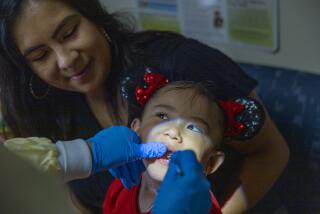Health 411: Lab fee differences; dental implant coverage
- Share via
My wife required blood hormone tests every two weeks for a while. One lab cost $30 but another charged $145 for the same test. Both were listed in our Blue Shield PPO insurance information.
When we inquired about the higher bill, the lab that charged $145 said it was simply a more expensive lab. Is there any recourse?
Generally, two contracted labs in the same geographic area should charge the same rate for the same procedure, says Johnny Wong, spokesman for Blue Shield of California. There are a number of possible reasons why one lab cost more than the other in this case.
The first possibility is that the higher-priced lab is not, in fact, in your insurer’s network. Based on the charges you describe, it’s quite possible it wasn’t, says Amy Ford Keohane, president and chief marketing officer for Philadelphia-based MedClaims Liaison, a patient billing advocate organization. As you know, with a preferred provider organization (PPO), you can see a doctor or visit a lab or hospital outside of your insurer’s network, but you’ll pay a higher price for doing so.
Verifying a lab’s status requires going beyond merely looking in your insurance carrier’s information booklet or on its website, because provider networks change all the time.
You can challenge the charges if you have a printout of the book with the lab listed as in-network, says Erin Moaratty, chief of external communications with the Patient Advocate Foundation, a national nonprofit based in Hampton, Va. But you’ll have a slim chance of winning the fight, because there are messages posted throughout such books saying you have to verify the information. The onus is on you to make sure the information is up to date.
In short, if you failed to confirm the lab’s network status before your appointment and it’s no longer contracted with Blue Shield, you’ll probably have to eat the extra cost.
The situation is different if a Blue Shield customer service representative told you over the phone that both labs were in your plan’s network. Then it’s worth contesting the higher charges. You can ask the insurer to produce its call log — the recording insurers make and store of all telephone contact with members — to confirm that you acted on bad information supplied by a company representative, Ford Keohane says.
Another possibility: Someone may have made a billing error. One of the labs may have used the wrong procedure code — an identifying number that corresponds to a specific medical service — used to bill your insurer. You can request an itemized statement from each lab to make sure that both billed for the same test.
Or maybe Blue Shield made a mistake, accidentally processing your claim as though it was not in Blue Shield’s network even though it is.
Sometimes, too, in-network providers will charge patients additional money beyond what they’ve contractually agreed to charge. That’s a practice called balance billing — and it is illegal. It’s something you should fight.
Finally, consider that your deductible — the amount of money you must pay before insurance picks up the bill — could be the cause of the disparity. If, for example, the first test took place in December after your annual deductible had been met and the next was in January, your out-of-pocket costs will be higher the second time around. That’s because a new year brings a new insurance deductible you have to satisfy.
To address any possible errors, your first move is to call the Blue Shield customer service number on the back of your member ID card, Wong says. Basic billing mistakes or other misunderstandings should be resolved over the phone.
If you’re not satisfied with the result of this call, you have the legal right to officially appeal your insurer’s decision. Your insurer must provide you with the guidelines to file internal appeals (the first-level appeal conducted by the insurer) as well as external appeals (reviewed by an independent third party as a next step if the first appeal doesn’t go your way).
If you are unhappy with the outcome and feel your insurance carrier has acted improperly, you can then file a complaint with your state’s department of insurance. Links to departments around the country can be found on the National Assn. of Insurance Commissioners website: Go to https://www.naic.org, click on “States and Jurisdictions Map” and then click on your state.
Most of my teeth are broken. I badly need dental implants. The AARP offers a dental plan that costs $60 a month for a benefit maximum of $1,500 per year. I was told that the price of a full mouth of dental implants is about $16,000. Could I buy into a plan that would allow me to get all the implants after a reasonable time?
Although implants are covered by most dental insurance plans, none will come close to helping you pay a $16,000 bill.
Dental insurance, by design, is intended to encourage preventive treatment. “It’s a form of protection that will help you get and stay healthy — and when major expenses come up, it will [pick up a small portion of] costs, but it certainly will not cover them,” says Jeff Album, vice president of public and government affairs at Delta Dental of California.
That’s why most dental plans pay 100% for preventive services, such as cleanings,X-raysand checkups, 80% for basic restorative services such as fillings and periodontal cleanings; and provide help paying for more complex procedures, such as implants and crowns — but at only 50% of the cost up to the annual maximum, which commonly ranges from about $1,000 to $1,500. That means at most you’re getting about $750 toward the cost of implants from insurance.
And you will have to wait for coverage to kick in for anything beyond cleaning, X-rays and checkups. A six-month waiting period is generally required before insurance picks up the bill for most dental procedures — even a filling, says Carrie McLean, consumer specialist for the online insurance broker eHealthinsurance.com. For crowns and root canals, 12 to 18 months is typical.
But there are still ways to cut down on cost.
You may be able to reduce your expenses through a dental discount plan, suggests Evelyn Ireland, executive director of the Dallas-based National Assn. of Dental Plans. These offer reduced rates on a host of procedures, including those considered cosmetic. These plans are not insurance, but dental services are discounted by 10% to 60% as long as your care is delivered by one of the plan’s participating dentists.
You can find a plan for as little as $7 to $15 per month by searching online at DentalPlans.com, a site exclusively dedicated to selling discount plans. Sites such as eHealthinsurance.com and DentalInsurance.com also sell them, along with regular dental insurance.
Explore whether you truly need implants — seek several expert opinions before going ahead with them. Dental crowns and tooth bridges are less expensive but often adequate solutions for teeth that need to be replaced or pulled, Album says. The price for a crown and bridge, which is a fixed prosthetic device, will run $900 to $1,100 a tooth as compared with $2,000 to $3,000 for one implant. “Most dentists would say the implant looks better and feels better in your mouth, but they both work,” Album says.
Whatever type of repair you choose, you’ll want to make sure you’re getting the best price, so seek two or three estimates, Album advises. You can find the average cost of the procedure you need by entering your ZIP Code at https://www.fairhealthconsumer.org, then ask dentists to accept the rate you find on the site — or better yet, negotiate to further lower your costs. Paying cash often gives you a better shot at a discount.
Try testing ZIP Codes outside of, but close to, where you live. “Different providers in an outlying area may be less expensive,” Ireland says.
And don’t go to an implant center where the business model is to provide implants, Album adds. They tend be more costly and, since all they sell are implants, that’s likely what they’ll suggest for you, even if other appropriate options exist. Besides, a specialist isn’t needed here; regular dentists and periodontists can perform the procedure and are likely to offer you a better price.
Schools of dentistry also provide excellent treatment by students under close professional supervision, and you’ll get the best price by far this way and can count on an accurate diagnosis, Album says. For a list of schools, check out the American Dental Assn.’s website at https://www.ada.org/267.aspx.
Finally, community health centers sometimes offer dental care on a sliding fee scale. You can find one near you by getting in touch with your local health department.
Zamosky has been writing about how to access and pay for healthcare for more than 10 years.
Got a healthcare dilemma? Email [email protected] or write to Health 411, Los Angeles Times Health, 202 W. 1st St., Los Angeles, CA 90012.
More to Read
Inside the business of entertainment
The Wide Shot brings you news, analysis and insights on everything from streaming wars to production — and what it all means for the future.
You may occasionally receive promotional content from the Los Angeles Times.










